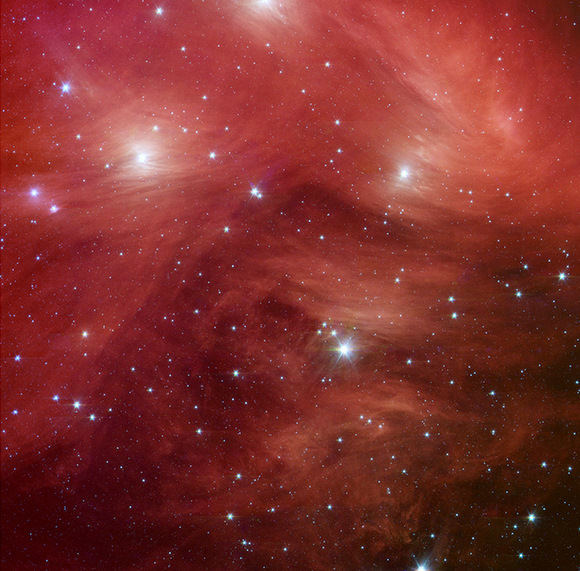Ready for another Where In The Universe Challenge? Here’s #70! Take a look and see if you can name where in the Universe this image is from. Give yourself extra points if you can name the spacecraft responsible for the image. As usual, we’ll provide the image today, but won’t reveal the answer until tomorrow. This gives you a chance to mull over the image and provide your answer/guess in the comment section. Please, no links or extensive explanations of what you think this is — give everyone the chance to guess.
UPDATE: The answer has been posted below.
Best answer this week: Mutara Nebula. Unfortunately, that is the wrong answer! Everyone certainly seems to know their sisters. Yes, this is the Pleiades taken by the Spitzer Space Telescope. The Pleiades located more than 400 light-years away in the Taurus constellation. The star cluster was born when dinosaurs still roamed the Earth, about 100 million years ago. It is significantly younger than our 5-billion-year-old sun. The brightest members of the cluster, also the highest-mass stars, are known in Greek mythology as two parents, Atlas and Pleione, and their seven daughters, Alcyone, Electra, Maia, Merope, Taygeta, Celaeno and Asterope. There are thousands of additional lower-mass members, including many stars like our sun.
Check back next for another WITU Challenge!


M45 – The Pleiades
Picture is from Spitzer Space Telescope
The whispy structures look like the Pleiades. Or part of them, anyway. This isn’t visible, though: in visible they’d look blue. I don’t know what’s the observatory.
This looks similar to the Pleiades cluster of stars. The stars are hot B class stars and usually have lots of blue. This is red, which makes me suspect this might be a Spitzer image.
LC
It’s the Pleiades; Spitzer?
Squefinitely the Pleiades. I’d recognise the wispy intricacy of the Merope nebula no matter what wavelength it was captured in I reckon!
Pleiades?
i think they are the pleiades, the seven sisters, not so far away from the hyades; but their colours puzzled me a bit as i know the cluster always looks blue, not red; i suppose the pic was taken by SPITSER
Andrew
You all said it already. Spitzer image of the Pleiades! (as you can see in the image EXIF data too :))
Wow…finally one for which i know the answer to both parts!!!
Pleiades by Spitzer…
It is the universe seen through cotton candy by J. Stauffer.
It’s the Mutara Nebula…..KKKKhhhhaaaannnnnn!!!!!!
Yep, the Pleiades. Thanks for listing the name of those stars… very interesting.
I wonder if the Maiar live on a planet orbiting Maia.